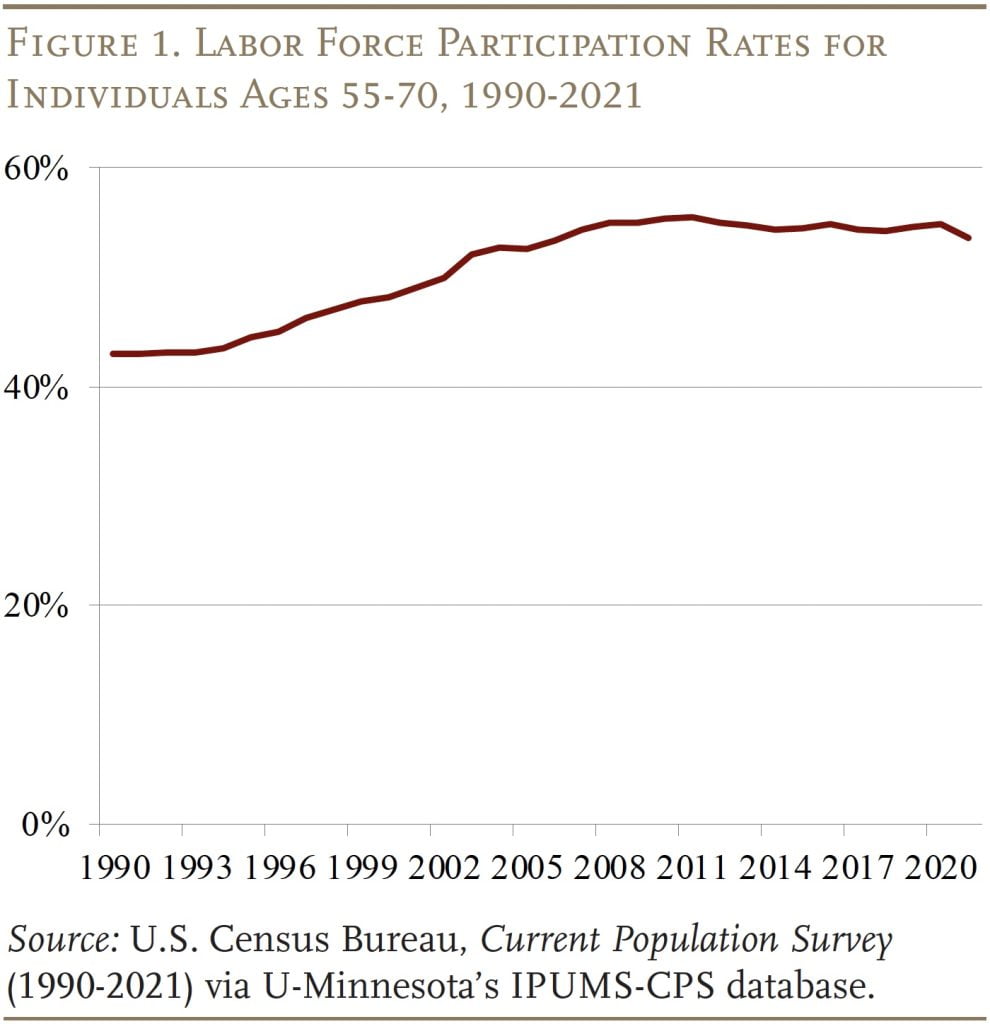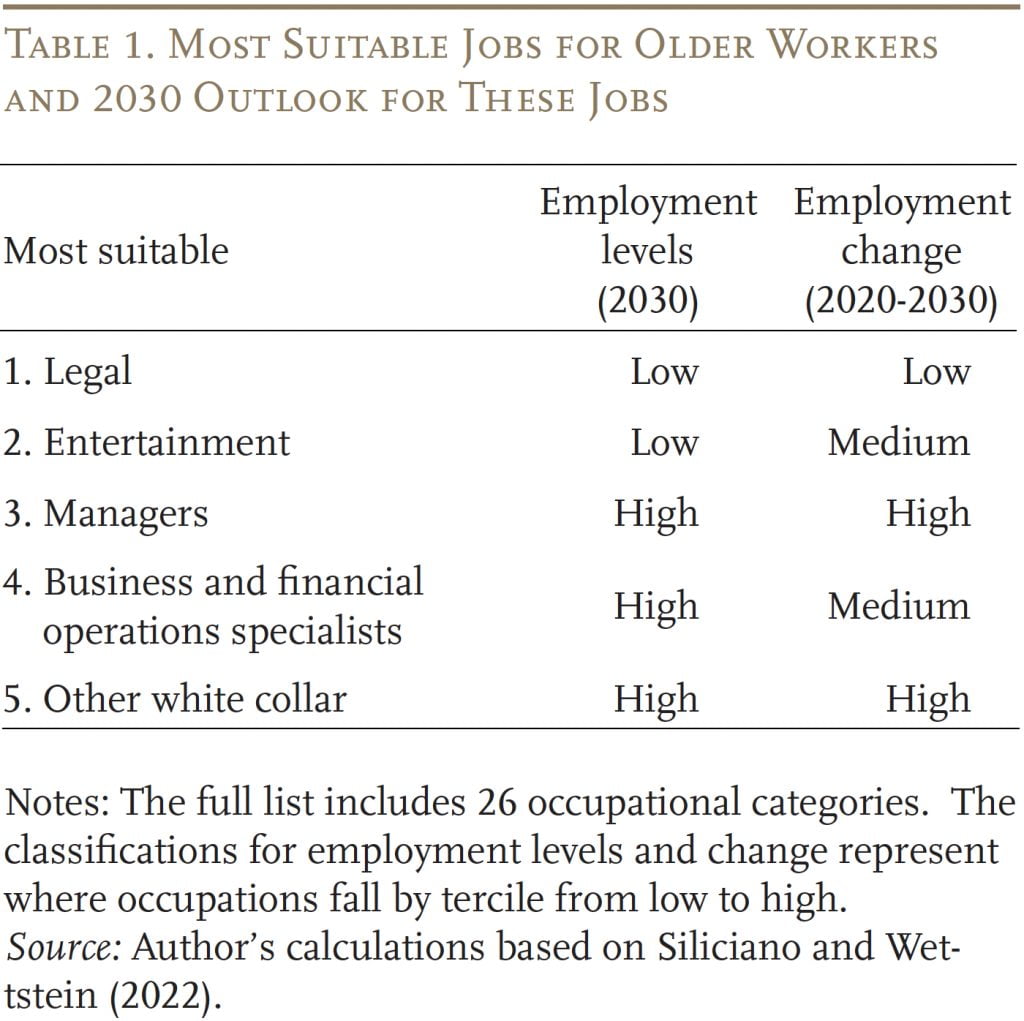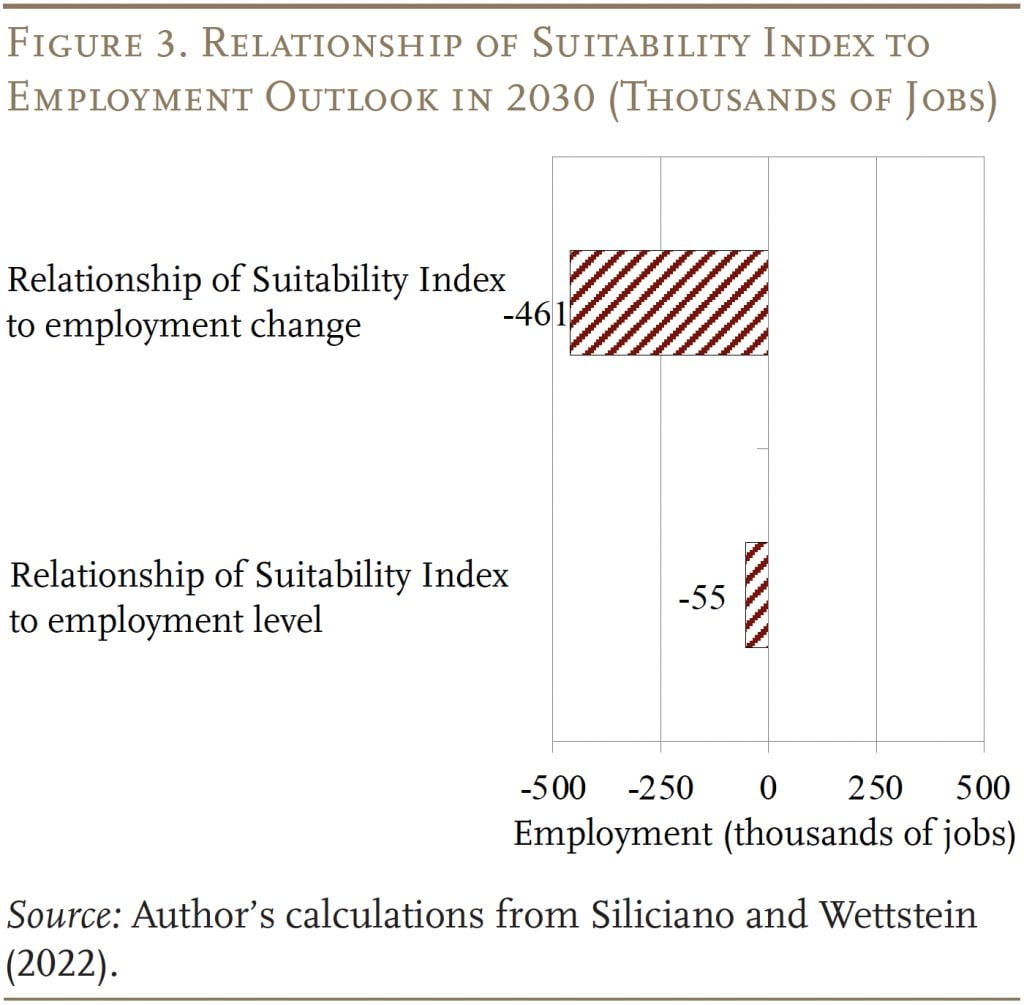
Will the Jobs of the Future Support an Older Workforce?
The brief’s key findings are:
- The trend has been toward working longer, but further progress could run into headwinds.
- Will employers find older workers’ skills well suited to the jobs of the future?
- An initial analysis finds that jobs currently employing older workers are projected to grow relatively slowly between now and 2030.
- But, such a finding does not hold for jobs that they could do, suggesting that these jobs will not grow less rapidly than jobs in general.
- This negative result suggests that the jobs of the future should be able to support an aging workforce.
Introduction
In recent decades, older workers have generally been working longer, which boosts prospects for a secure retirement. However, continued progress could run into headwinds in the coming years. On the supply side, some individuals may be reaching the physical limits of longer worklives. And even if workers can work longer, they must find employers willing to hire or retain them.
This brief, based on a recent paper, looks ahead to 2030 and assesses how amenable the future labor market will be to older workers.1Siliciano and Wettstein (2022). By linking projections of future jobs to the types of jobs that are a good fit for older worker’s abilities, the analysis goes beyond simply looking at what jobs older workers do today to explore what they could do going forward.
The discussion proceeds as follows. The first section provides background on trends in working longer and potential obstacles. The second section summarizes the data and methodology for the analysis. The third section reports the results. The initial analysis indicates that jobs currently employing older workers are projected to grow relatively slowly. However, for the jobs that older workers could do, the analysis finds a lack of statistically significant results, suggesting that these jobs are likely to grow at the same pace as jobs overall. The final section concludes that the jobs of the future should be able to support an aging workforce.
Background
The rise in labor force participation among older workers since 1990 has been an encouraging sign for those worried about retirement security (see Figure 1), as postponing retirement is one of the best ways of ensuring that individuals have sufficient savings after leaving the labor market.2See, for example, Munnell and Sass (2009); Bronshtein et al. (2019); and Rutledge and Wettstein (2020).

The fly in the ointment is the concern that future prospects for working longer could be constrained by two factors. First, workers’ ability to do their jobs may be limited by the very process of aging. Second, people can only work when firms are willing to hire them. Of course, these two issues are linked, with firms potentially concerned about age-related declines in productivity, and thus less willing to hire older workers.
On the ability of older workers to work longer, a few recent studies have found relatively favorable prospects for whites and educated workers and unfavorable prospects for low-education and Black workers.3Quinby and Wettstein (2021). Also see Coile and Duggan (2019) on the prevalence of work-limiting disability. With respect to employer demand, research generally finds that employers say they want to hire older workers for a range of jobs, despite moderate concern about their productivity and more significant concern about their relative cost.4Munnell and Wettstein (2020). However, expressing a willingness to hire and actually hiring are different things, and the perceptions about cost may help explain the persistence of age discrimination.5Neumark, Burn, and Button (2016).
These studies look at broad trends in the population. At a more granular level, some research has examined which individual capabilities grow or hold steady to older ages, and which decline.6On the physical side, see Spirduso, Francis, and McRae (2005). On the cognitive side, see Singh-Manoux et al. (2012); Salthouse (2012); and Gross et al. (2011). For example, capabilities that depend on accumulation of knowledge (e.g., verbal abilities) tend to increase with age. Conversely, capabilities that require fluidity (such as memorization) tend to show early declines.7Belbase, Sanzenbacher, and Gillis (2017) (referred to hereafter as BSG). While workers generally experience declines in fluid cognitive ability, considerable variance exists between workers as in Ylikoski et al. (1999).
Bringing together the questions of supply and demand for older workers, this analysis explores whether the jobs that are projected to be more plentiful in the coming years are a good match for the jobs that older workers are capable of doing.
Data and Methods
To gauge the suitability of older workers for future jobs, the analysis uses two complementary approaches. First, it considers whether occupations in which older workers are currently employed are projected to grow. Second, it projects whether the jobs they could do will grow less rapidly than jobs overall.
Approach 1: Jobs They Are Doing Now
The most direct way to gauge future prospects for older workers is to examine whether their current jobs are projected to be in high demand, measured here using BLS data on the level of jobs in 2030 and the change in jobs from 2020-2030. Answering this question is straightforward. It requires estimating, based on data from the Current Population Survey, the share of each occupation’s workers who were over 55, and using a regression to estimate the relationship between “older worker” jobs and future jobs, as follows:
(1) Employment in 2030 in occupationi =
f (% of older workers in occupationi)
(2) ∆ in employment (2020-2030) in occupationi =
f (% of older workers in occupationi)
A major limitation of this approach is that it may not capture the jobs of those who will be older workers in 10 years. The older workers of 2030 are, in large part, the prime-age workers of today, who may currently be in different jobs than today’s older workers, and they also may change jobs as demand shifts.
Approach 2: Jobs They Could Do
The first step in assessing how older workers’ abilities match up with different jobs is to create a Suitability Index, which is composed of three indicators for each occupation: 1) the extent to which the skills needed erode with age; 2) the disability application rates; and 3) the average retirement age.8The first indicator is from BSG that created an index measuring the susceptibility of different occupations to skill erosion. The second indicator is calculated from the Survey of Income and Program Participation (SIPP) in the years 2004-2008. The third measure comes from the Health and Retirement Study (HRS) in the years 2004-2016. Each of the three measures of job suitability that comprise the Index has its own classification for occupations. For this analysis, a new occupational classification was developed to (roughly) harmonize the different classifications used by each Index component. The Index provides a convenient summary measure of which occupations are most congenial to older workers.9The Index also helps preserve statistical power in this setting, in which the analysis is based on only a relatively small number of observations. To validate the Suitability Index, the analysis first confirmed that the occupations the Index deems suitable for older workers do, in fact, employ high shares of older workers currently.
The second step is to estimate a regression that measures the correlation of the Index with the growth of future jobs. The equation uses the same two outcome variables for future jobs: employment level and change. The independent variable is simply the Index value for each occupation, which is 0 for an occupation of average suitability for older workers. A 1-unit change in the Index corresponds to a 1-standard deviation change in suitability.
Harder than It Looks!
As you can see, the hard part of the Index exercise was not the regression analysis. Instead, the challenge was figuring out how to merge different occupational schemes from many sources – the BLS; the HRS; the SIPP; and BSG – into one. Not only did the groups themselves have to be sensible – don’t combine lab workers with lawyers – but they had to be large enough to allow us to estimate things. To navigate this complicated crosswalk, our intrepid research assistant Nico Nastri created a brand new list of 26 occupational categories. With a lot of effort, somehow it all worked out. For the handful of curious readers who want to know more, see the Appendix in the full paper.10Siliciano and Wettstein (2022).
Results
The regression results for the first approach show that the occupations that currently have larger shares of older workers are projected to have fewer jobs, measured by either the level or change in jobs (see Figure 2). This finding suggests a mismatch between the jobs older workers currently do and the jobs expected to exist in 10 years. Such a mismatch could stymie efforts to further lengthen working lives. However, as noted above, the jobs older workers currently hold may differ from those that older workers will hold in the future.

To account for these potential changes, the Suitability Index is used. Interestingly, simply looking at the raw data for the Index shows no discernible pattern between an occupation’s suitability for older workers and its future demand (see Table 1). Some jobs suitable for older workers are projected to have low demand; others high.

To test whether these descriptive results hold up, a regression was used. In total, these results show no statistically significant relationship between the suitability of occupations for older workers and the projected number of jobs in occupations in 2030 or the growth from 2020-2030 (see Figure 3). While usually a lack of significant results is disappointing, in this case it is heartening, because it suggests that jobs suitable for older workers are not going to grow less rapidly than jobs as a whole.

Conclusion
A key question for older workers’ job prospects going forward is how well suited will their skills be to the jobs of the future? This analysis addresses that question by linking projections of future demand for workers with the kinds of occupations that are a good fit for older workers. The analysis goes beyond merely looking at the jobs older workers do today to explore what they could do in 2030.
Overall, the findings show little relationship between the occupations that are suitable for older workers’ abilities and those that are projected to be in high demand in ten years. While the occupations currently employing many older workers are projected to grow relatively slowly, the lack of statistically significant results for jobs that older workers could do is more encouraging. It suggests that the jobs in occupations suitable for older workers should grow at the same pace as jobs in general — neither faster nor slower.
References
Belbase, Anek, Geoffrey T. Sanzenbacher and Christopher M. Gillis. 2017. “Beyond Blue and White Collar: Age-Related Decline, Occupation, and Retirement Timing.” Journal of Retirement 5(2): 26-41.
Bronshtein, Gila, Jason Scott, John B. Shoven, and Sita Nataraj Slavov. 2019. “The Power of Working Longer.” Journal of Pension Economics and Finance 18(4): 623-644.
Coile, Courtney C. and Mark G. Duggan. 2019. “When Labor’s Lost: Health, Family Life, Incarceration, and Education in a Time of Declining Economic Opportunity for Low-Skilled Men.” Journal of Economic Perspectives 33(2): 191-210.
Gross, A., G. W. Rebok, F. W. Unverzagt, S. L. Willis, and J. Brandt. 2011. “Word List Memory Predicts Everyday Function and Problem-Solving in the Elderly: Results from the ACTIVE Cognitive Intervention Trial.” Aging, Neuropsychology, and Cognition 18(2): 129-146.
Munnell, Alicia H. and Steven A. Sass. 2009. Working Longer: The Solution to the Retirement Income Challenge. Washington, DC: Brookings Institution Press.
Munnell, Alicia H. and Gal Wettstein. 2020. “Employer Perceptions of Older Workers – Surveys from 2019 and 2006.” Working Paper 2020-8. Chestnut Hill, MA: Center for Retirement Research at Boston College.
Neumark, David, Ian Burn, and Patrick Button. 2016. “Experimental Age Discrimination Evidence and the Heckman Critique.” American Economic Review 106(5): 303-308.
Quinby, Laura D. and Gal Wettstein. 2021. “Are Older Workers Capable of Working Longer?” Working Paper 2021-8. Chestnut Hill, MA: Center for Retirement Research at Boston College.
Rutledge, Matthew S. and Gal Wettstein. 2020. “Is Nontraditional Work at Older Ages Associated With Better Retirement Security?” Working Paper 2020-13. Chestnut Hill, MA: Center for Retirement Research at Boston College.
Salthouse, Timothy. 2012. “Consequences of Age-Related Cognitive Declines.” Annual Review of Psychology 63: 201-226.
Siliciano, Robert L. and Gal Wettstein. 2022. “Will the Jobs of the Future Support an Older Workforce?” Working Paper 2022-2. Chestnut Hill, MA: Center for Retirement Research at Boston College.
Singh-Manoux, A., M. Kivimaki, M. M. Glymour, A. Elbaz, C. Berr, K. P. Ebmeier, J. E. Ferrie, and A. Dugravot. 2012. “Timing of Onset of Cognitive Decline: Results from Whitehall II Prospective Cohort Study.” British Medical Journal 344: 7622.
Spirduso, Waneen W., Karen L. Francis, and Priscilla G. MacRae. 2005. “Physical Dimensions of Aging.” Champaign, IL: Human Kinetics.
University of Michigan. Health and Retirement Study, 2004-2016. Ann Arbor, MI.
University of Minnesota. Current Population Survey (IPUMS-CPS), 2018-2020. Minneapolis, MN.
U.S. Bureau of Labor Statistics. 2020. “Occupational Projections.” Washington, DC: U.S. Department of Labor.
U.S. Census Bureau. Survey of Income and Program Participation, 2004-2008. Washington, DC.
Ylikoski, R., A. Ylikoski, P. Keskivaara, R. Tilvis, R. Sulkava, and T. Erkinjuntti. 1999. “Heterogeneity of Cognitive Profiles in Aging: Successful Aging, Normal Aging, and Individuals at Risks for Cognitive Decline.” European Journal of Neurology 6(6): 645-652.
Endnotes
- 1Siliciano and Wettstein (2022).
- 2See, for example, Munnell and Sass (2009); Bronshtein et al. (2019); and Rutledge and Wettstein (2020).
- 3Quinby and Wettstein (2021). Also see Coile and Duggan (2019) on the prevalence of work-limiting disability.
- 4Munnell and Wettstein (2020).
- 5Neumark, Burn, and Button (2016).
- 6On the physical side, see Spirduso, Francis, and McRae (2005). On the cognitive side, see Singh-Manoux et al. (2012); Salthouse (2012); and Gross et al. (2011).
- 7Belbase, Sanzenbacher, and Gillis (2017) (referred to hereafter as BSG). While workers generally experience declines in fluid cognitive ability, considerable variance exists between workers as in Ylikoski et al. (1999).
- 8The first indicator is from BSG that created an index measuring the susceptibility of different occupations to skill erosion. The second indicator is calculated from the Survey of Income and Program Participation (SIPP) in the years 2004-2008. The third measure comes from the Health and Retirement Study (HRS) in the years 2004-2016. Each of the three measures of job suitability that comprise the Index has its own classification for occupations. For this analysis, a new occupational classification was developed to (roughly) harmonize the different classifications used by each Index component.
- 9The Index also helps preserve statistical power in this setting, in which the analysis is based on only a relatively small number of observations. To validate the Suitability Index, the analysis first confirmed that the occupations the Index deems suitable for older workers do, in fact, employ high shares of older workers currently.
- 10Siliciano and Wettstein (2022).








